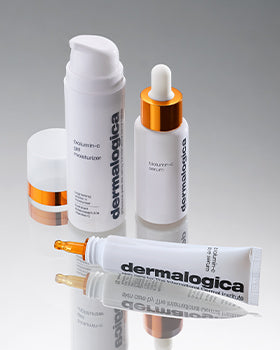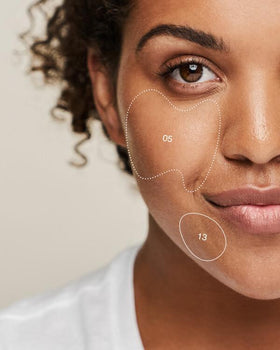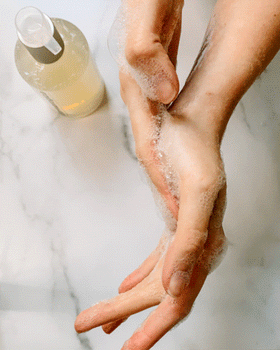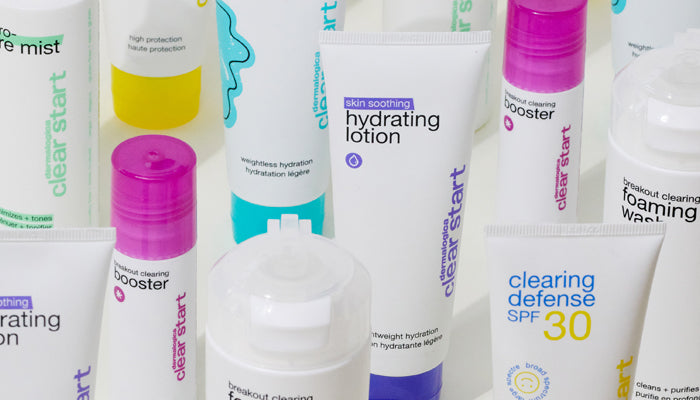It’s often thought that breakout-prone skin and skins that produce oil don’t need a moisturiser for their skin and that using a moisturiser will makes the oiliness and breakouts worse.
The good news is that in today’s market there is a wide variety of skincare products to suit everyone’s skin. The key with an oily or breakout-prone skin is to increase the topical water content. Hydration is the number one missed step in skin care routines.
Dehydrated skin can contribute to most skin problems and for some, is a major trigger of breakouts. It’s certainly a major cause of congestion and blackheads. Without hydration, you’ll never have a balanced routine or balanced skin.
What are the signs of a dehydrated skin?
Flaky skin: This can appear anywhere on your skin.
Oily skin: If your skin is oily, hydration is an absolute to slow down the oil production. If your skin has excess oil there is a very high chance it’s dehydrated.
Congestion: Congested pores, enlarged pores or pores that appear larger because they have a build-up of oil/dirt/debris in them.
Skin that absorbs moisturiser quickly, but still feels like it could use another big helping of moisturiser later in the day.
Dull looking skin, when our skin is well hydrated, it has a smooth, almost dewy appearance. It looks full and bounces back easily when touched. If your skin doesn’t feel smooth, there’s a good chance it’s dehydrated
Hydrated skin is a more balanced skin
To be healthy our skin needs a balance of water inside the skin and oil just outside the skin. When we don’t have enough water, our skin often reacts by pumping out more oil to make up for the lack of water. Oil acts as a protective layer for the skin, if the skin can’t hold on to enough water, our skin thinks we don’t have enough hydration and produces more oil to compensate.
Another reason that hydration is important, especially for breakout-prone skin, is for our pores to remain clear, oil needs to pass through them on the way to the surface of the skin without being held up or slowed down by anything. When our skin is dehydrated, our pores aren’t well lubricated. Oil can’t pass through them as easily as we’d like. When the oil is slowed down or gets caught up by dead skin cells that are stuck in our pores, it runs the risk of drying up. This creates a hard plug or blockage inside the pore which creates congestion, blackheads, and breakouts.
What can I do to help a dehydrated skin?
You can use skincare products to topically increase the water content of your skin. Choosing products that are oil free will ensure that you’re not putting any more oil onto your skin, only hydration. Our Clear Start range is designed specially for oily breakout-prone younger skins which will all help with dehydration as they help to control oil and breakouts. The two moisturisers that we have within the range that target increasing your hydration levels are:
Our Skin Soothing Hydrating Lotion is great for a dehydrated skin and contains Hyaluronic Acid that provides instant relief from skin dehydration. This is fantastic to use at night time. If your skin is particularly oily and you find that you get an oily shine on your skin we have our Cooling Aqua Jelly which also contains Hyaluronic Acid. Don’t forgot to drink plenty of water too!
For further support with finding the best hydration for your skin here’s where to get help from a Dermalogica Skin Therapist.
Face Mapping is a service that Dermalogica offers to help you with your skin goals and find products that will truly work for you. Face Mapping involves looking at your skin with a trained eye, touching your skin and asking you questions about your lifestyle and environment.
1. Face Mapping
Face Mapping finds out your skin type as well as any skin conditions present and reveals any possible underlying causes of skin conditions you might have. These insights drive the recommendations made in your personalised Skin Fitness Plan.
Face Mapping can be performed in any of our Dermalogica Skin Centres or retail locations where a Dermalogica Skin Therapist is present – check out our store locator to find the nearest to you.
2. Chat to a Dermalogica Skin Therapist
Alternatively, book a virtual skin consultation with one of our in-house Dermalogica Skin Therapist’s or chat to us online via the chat box in the bottom right-hand corner of the screen. For more information on how to book a virtual consultation or our online chat hours please click on this link.



